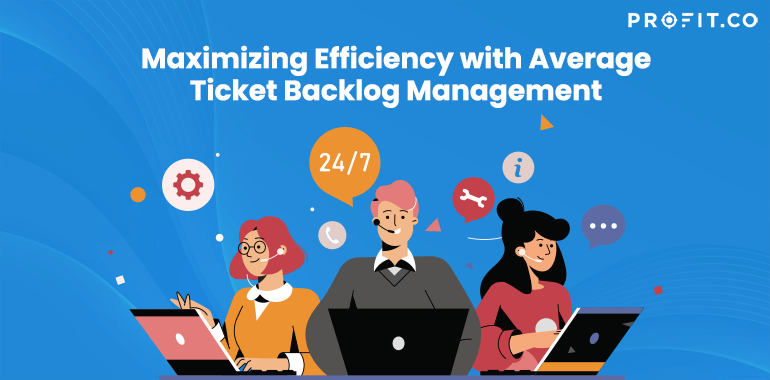Introduction
In the fast-paced world of customer support, managing ticket backlogs efficiently is crucial for maintaining customer satisfaction and operational effectiveness. The Average Ticket Backlog is one key metric that helps businesses gauge their backlog management. A ticket backlog is an important aspect that should be immediately addressed without any delay, as it can lead to longer resolution times, aggravate customer frustration, and may affect customer satisfaction in the long run. A Forbes article states that brands with superior customer experience generate 5.7 times more revenue than competitors that lag in customer experience. So, by understanding this metric and implementing effective strategies, companies can streamline their support processes, improve response times, and ultimately enhance the overall customer experience.
What is the Average Ticket Backlog?
Average Ticket Backlog KPI refers to the average number of unresolved tickets at any given time. It provides valuable insights into the volume of pending support requests and the workload on support teams.
Calculation
The metric is calculated by dividing the total number of unresolved tickets by a specific period (e.g., daily, weekly, or monthly).
Formula

Example
If you have 200 unresolved tickets in a week
Average Backlog = 200 / 7 (assuming a weekly period) = 28.57
This means that, on average, there are approximately 28.57 unresolved tickets in the Backlog each day during that week. By tracking this metric, businesses can identify potential bottlenecks, allocate resources effectively, and implement strategies to reduce Backlog and improve customer satisfaction.
Ready to start measuring your progress?
Importance of Average Ticket Backlog Management
Improved customer satisfaction
Businesses can promptly respond to customer inquiries by reducing the average ticket backlog and increasing customer satisfaction.
Enhanced operational efficiency
Streamlining the average ticket per customer resolution process helps optimize resource allocation, enabling support teams to handle customer requests more efficiently.
Better resource planning
By analyzing the average ticket backlog over time, businesses can identify peak periods and allocate resources accordingly, ensuring adequate support coverage during high-demand periods.
I have been struck again and again by how important measurement is to improving the human condition.
Strategies for Managing Average Ticket Backlog
Prioritize and categorize tickets
Implement a ticket prioritization system based on urgency and impact to focus on high-priority issues first. Categorize tickets based on common themes to identify recurring problems and develop proactive solutions.
Implement automation and self-service options
Integrate automation tools and self-service options, such as chatbots or knowledge bases, to handle common customer inquiries efficiently and reduce the workload on support teams.
Empower support agents
Provide support agents with the necessary training, resources, and tools to handle tickets effectively. Encourage collaboration and knowledge sharing among team members to improve problem-solving capabilities.
OKRs are an Effective Solution to Manage Average Backlog KPI
OKR Examples
Objective: Streamline the Ticket Management Process
Key Result 1: Decrease Average Ticket Backlog by 20% through efficient ticket handling and resolution
Initiative: Implement a ticket triage system to prioritize and assign tickets based on urgency and skillset, ensuring faster response and resolution times.
Key Result 2: Improve Ticket Resolution Time by 15% to enhance customer satisfaction
Initiative: Conduct training sessions for support agents to enhance their technical skills and problem-solving abilities, enabling them to resolve tickets more efficiently.
Key Result 3: Enhance Self-Service Options to Reduce Ticket Volume by 10%
Initiative: Develop and promote a comprehensive knowledge base and self-help resources for customers to find answers to common issues independently.
The organization can effectively manage the Average Ticket Backlog KPI by aligning efforts and focusing on these key results of customer success OKRs.
Best Practices for Tracking and Monitoring Average Ticket Backlog
Regular reporting and analysis
Generate regular reports to monitor the average ticket backlog and identify trends or patterns. Analyze the data to gain insights into the Backlog’s root causes and identify improvement areas.
Set realistic targets
Establish realistic targets for reducing the average ticket backlog based on historical data and industry benchmarks.
Continuous improvement initiatives
Implement ongoing improvement initiatives, such as process optimization, training programs, and feedback loops, to address underlying issues contributing to the backlog and drive efficiency.
Conclusion
Managing the average ticket backlog effectively is vital for delivering exceptional customer support and maintaining operational efficiency. By implementing strategies, tracking the metric, and continuously improving processes, businesses can enhance customer satisfaction, optimize average replies per ticket, streamline support operations, and build stronger customer relationships. Remember, efficient backlog management is critical to success in today’s competitive business landscape.

